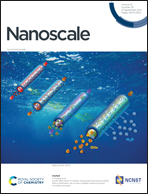Boosting the photothermal performance of vacancy-rich MoSe2−x nanoflowers for photoacoustic imaging guided tumor chemo-photothermal therapy†
Abstract
Due to the relatively low photo-thermal conversion efficiency and poor tumor targeting capacity, phototheranostic nanoagents encounter some challenges in cancer photothermal therapy. To address this problem, in the current research we developed vacancy-rich MoSe2−x (0 ≤ x ≤ 1) nanoflowers (MNFs) with molecular 2-deoxy-D-glucose (2-DG) as the activity target, which could be used as a novel phototheranostic nanoagent in the photoacoustic imaging guided chemo-photothermal synergistic therapy. This selenium-deficient structure endows MNFs with high photothermal conversion efficiency (41.7%) due to the strong localized surface plasmon resonances. Besides, the surface linked 2-DG molecules and the flower-like morphology in the nanoagents promoted the targeting effect (active and passive), thus facilitating the efficient concentration of the nanoagents within the tumor site. Both in vitro and in vivo anti-tumor experiments have demonstrated the high synergistic efficacy promoted by MNFs and complete tumor eradication with lower administration dosages could be achieved. This rational design of nanoparticles not only provided the paradigm of high therapeutic efficacy of a chemo-photothermal protocol for precise cancer theranostics, but also expanded the scope of nanomedical applications using semiconductor-based nanoplatforms through well-defined designing of their microstructures and physiochemical properties.



 Please wait while we load your content...
Please wait while we load your content...